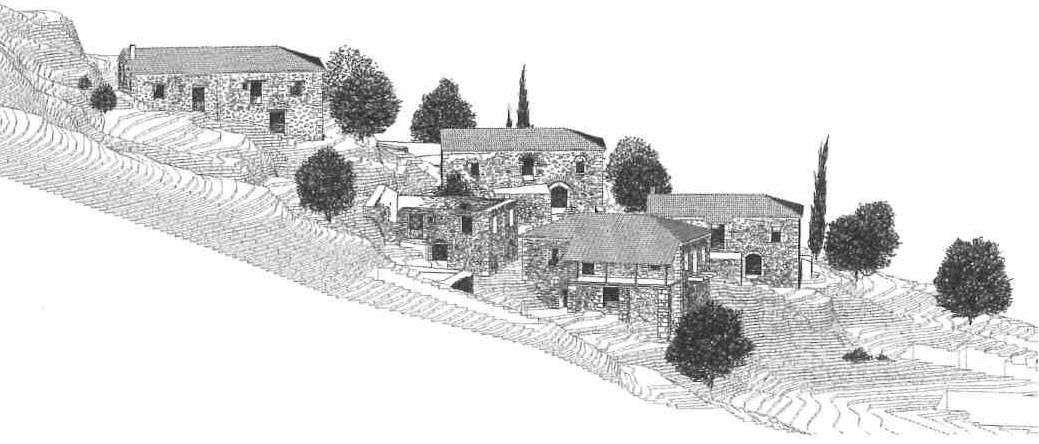MESSINIAN ARCHAEOLOGICAL RESEARCH CENTER
1. Lodging for 18 to 20 researchers or students, three professors, and space for the permanent personnel
2. An assembly room with multiple possibilities
3. A restaurant
4. A unit of laboratories, which includes a conservation and restoration laboratory with storeroom, photographic laboratory and a space with drawing tables.
5. Offices for the three professors and secretary, a room with computers and space for the storage of files.
6. Small library.
7. An outpost at the entrance for the guard
8. An open-air amphitheater
9. The outdoor spaces are organized and re-fashioned, plateaus are shaped, steps and ramps are created.
10. A parking area
The total area of required spaces reaches 950 m2. Therefore, for the needs of the compound, an additional enclosed area of 450 m2 must be realized.
Our initial intention is to satisfy the functional requirements with the least possible intervention. The integration-incorporation however, of new buildings is imposed by the building project. Immediately the matter begins to get complicated. It acquires a new dynamic and architectural interest, as it brings up the issue concerning the relationship between local traditional identity and modern architectural creation.
When the existing historical structures are changed with the addition of new masses, the traditional character is automatically altered. The fragile balance can be preserved only if the diachronic complex preoccupations and the true principles and unwavering values of architecture are understood and respected.
Every intervention in a group of buildings or single house has to produce an eloquent dialogue with the spirit of the place where it belongs. In this respect, various planning strategies can be advanced. Our theoretical approach is directed to an immediate rapport with the existing environment without insensitive copying of local characteristics and mindless repetition of old forms. The new buildings we select "converse" with the neighboring ones through the creations of volumes, the scale of spaces, etc. Modern forms are in a way the continuation of traditional architecture since they are inspired by it. In other words, we tried to comprehend, rediscover and evoke the non geometric, ostensibly accidental logic that we have before us; to absorb, to translate geometrically, to render as drawings and to rewrite it synthetically.
In our case we are not dealing with a listed historical settlement, for which special terms of layout are in effect. This leaves us of course with a large scope of action and the possibility of using new construction materials.
The effort of a complex resolution-proposal was exhaustive on the one hand in the rationalization of the existing environment, on the other hand, in the harmonious incorporation of added structures, in such a way that the entire group can function as a whole. In our general decision to create geometry out of randomness, we used a charting that follows the ground and stresses the bas-relief.

The operations were divided into two
sub areas: a southern one with an obvious communal character and
another, northern one, which is more private. The whole group is
divided by a central pedestrian road that can be considered to be the
unifying element of the total. Through this road, access can be had to
most of the closed spaces. The remaining accesses ensure a second
movement, vertical at first, one that snakes its way up by way of steps
and ramps. More concretely, the choices that determined the final form
of our resolution are as follows: It was decided that the addition of
the new central building was to be placed between houses No. 10a and 10
since they are sufficiently removed from each other. The new building
is joined to the ground floor of the first house.